A Radical Turn
A physician recalls the fight to achieve equitable medical care for the Black community in one small town in Louisiana
- 14 minute read
- Perspective
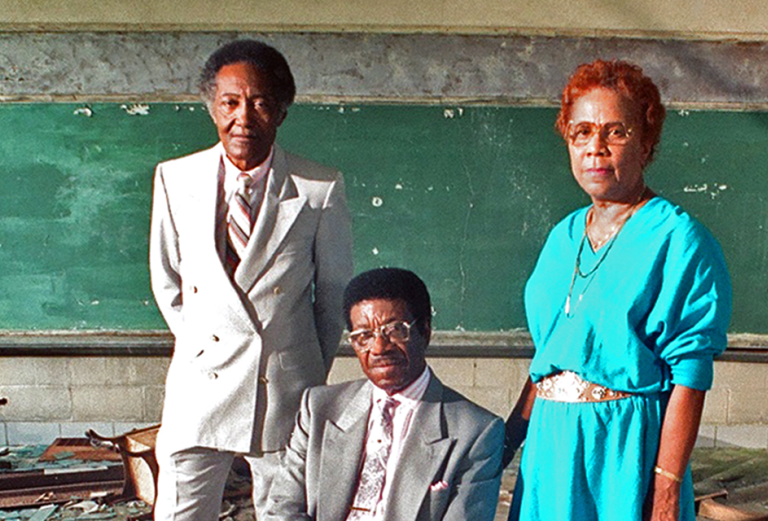
This 1988 photo shows three of the people who contributed significantly to the fight for the civil and voting rights of the Black community in Bogalusa, Louisiana: Robert Hicks (left), A.Z. Young (center), and Gayle Jenkins (right). They are in the abandoned Poplas Elementary School. Many of the all-Black segregated schools were closed after Bogalusa fully integrated its schools in 1969.
A garden party in Washington, DC, was not a venue I would have thought would lead to my becoming radicalized and deeply involved with a small group of southern Black men and women seeking their civil rights. Yet, it was the first step on a road to precisely that.
In the summer of 1964, my wife, Judy, and I attended such a party. As we mingled with the other local health professionals, we learned about a group of doctors and nurses, members of the Medical Committee for Human Rights (MCHR), that was providing medical care for student volunteers in Jackson, Mississippi, who were registering Black voters. The MCHR had been founded in 1963 by medical luminaries from New York and Boston, some of whom I had met while a medical student at HMS.
In 1965, the MCHR wished to identify and rectify health disparities in the state of Louisiana. I volunteered to help with this. By March of that year, I had procured travel orders from the somewhat hesitant director at the NIH, where I was a Public Health Service (PHS) officer doing research. I was approved to go to Bogalusa, a small town in northeast Louisiana tucked near the border with Mississippi, to survey hospitals and available race-related statistics, conduct interviews, and produce a survey report that would help the MCHR prepare for the deployment it was planning in Louisiana for later that year.
In my third year at HMS, I had taken a public health course in which I surveyed Trenton, New Jersey. I evaluated health delivery resources provided by the private sector, the city, the state, and the federal government. I also analyzed published health statistics and racial disparities, visited hospitals and clinics, and interviewed doctors, nurses, health administrators, and patients. My supervisor at HMS, Joseph Stokes, MD ’49, a cardiologist and epidemiologist at Massachusetts General Hospital and a founder of the MCHR, had approved my report and even suggested that I consider going into public health.
Riding shotgun
To prepare for my work in Louisiana, I reviewed health statistics for the state while also reading disturbing news of civil rights protests and their violent suppression in Bogalusa and elsewhere in the South. Nevertheless, I remained committed to my decision to go.
Race-based atrocities in the region were many. In 1964, three young civil rights workers had been killed by the Ku Klux Klan in Philadelphia, Mississippi, about 150 miles northeast of Bogalusa. In February 1965, a civil rights organizer from the Congress of Racial Equality (CORE) was severely beaten in Bogalusa by the Klan. One month later, in Selma, Alabama, Black and white protesters were beaten by police during a nonviolent march; one person was killed and many were injured, including John Lewis, a young Black activist and later a member of the U.S. House of Representatives.
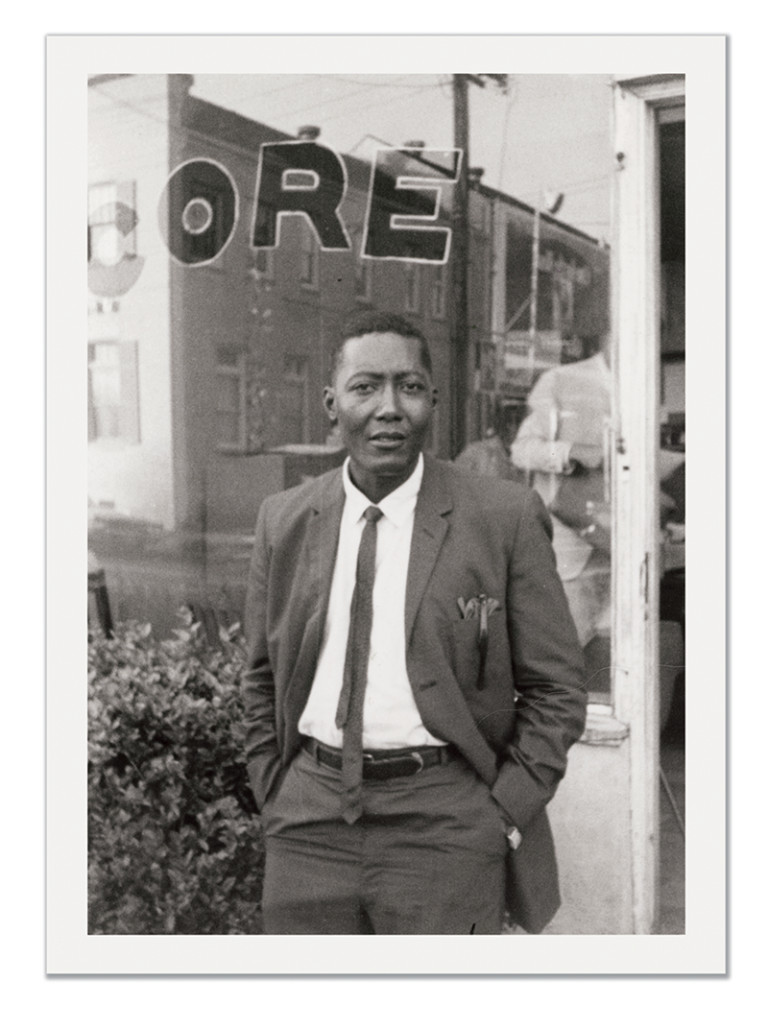
Voter registration efforts in Bogalusa were burgeoning; CORE and the Bogalusa Civic and Voters League, organized by members of the Black community, announced that volunteers would be coming to the city and that, in early April, the CORE director, James Farmer, would lead a protest march targeting segregated lunch counters and other facilities. The Black community in Bogalusa mobilized; in early 1965 it formed the Deacons for Defense and Justice, an armed defense group dedicated to protecting the community and civil rights demonstrators from the Klan and the police, many of whom were themselves members of the Klan.
This was the environment I entered on the evening of March 30, 1965, when I landed at the New Orleans airport. As the plane touched down, I could almost hear the warning of the NIH director: “Whatever you do, Stanley, do not get involved in any civil rights disturbance, and do not mention that you are from the NIH or are a PHS officer. That could get us all in trouble.” I had readily and, it turned out, naively, agreed.
I was met at the baggage claim by Joel Rubenstein, who introduced himself as a Bogalusa CORE representative. We climbed into his car and headed not north for Bogalusa, but south toward CORE headquarters on Dryades Street in the Black quarter of New Orleans. There, I reviewed my plans for my next few days in Bogalusa with the southern director of CORE. With his help, I identified people that I should meet and places I intended to survey. I especially wanted to visit the Washington-St. Tammany Charity Hospital, an institution built in 1951 with Federal Hill-Burton funds and subject to the Title VI desegregation requirements in the recently passed Voting Rights Act. When I finished discussing my plans, Joel told me that while in Bogalusa I would be the guest of the Hicks family.
Subscribe to Harvard Medicine magazine
Joel and I were headed north for Bogalusa by 10 p.m. Before putting the car in gear, Joel removed a black oiled revolver from his briefcase and placed it between our seats. “What the hell are we doing with a gun?” I asked him. “Well,” he said, “as long as it’s not concealed, it’s legal in Louisiana. There’s the Klan out there.”
Far from equal
We drove along the Causeway, a 23 mile-long concrete highway above Lake Pontchartrain. At a sign announcing Mandeville, the Causeway diverged into a narrow, soggy road. After about 30 minutes, our car quietly entered a barely lit agglomeration of houses. This was Bogalusa. We crossed a bridge to reach the home of Robert (Bob) and Valeira (Jackie) Hicks. Nervous Black men carrying shotguns surrounded me as I stepped out of the car. I became aware of a sulfurous stench in the air—the unhealthy effluent from the distant chimneys of the Crown Zellerbach paper mill.
I was greeted at the opened door by Jackie, a slight woman who grabbed my battered valise and tugged me into the darkened room where her husband was standing. She told me not to walk in front of a window and to keep the lights dimmed in the house at night, to avoid being a target. A shotgun leaned against a wall.
Jackie offered me a sandwich and a glass of milk, and we talked of my plans for the next few days. Bob told me that he had just been elected vice-president of the League and that I would soon meet A.Z. Young, the League’s new president and owner of a small fleet of taxicabs that served the Black community. Both men worked at the paper mill and belonged to its long-established Black union. Later, Jackie showed me to what was evidently a young boys’ room where I would spend the night. Her sons Greg and Rob were staying with A.Z.
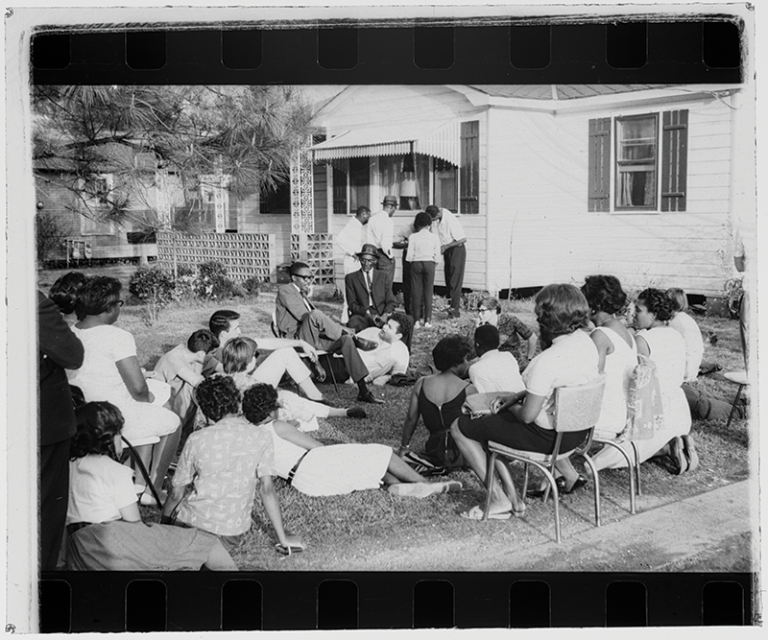
In the morning, an armed man, a Deacon, drove me to St. Matthews Episcopal Church to meet with its pastor. I reviewed with him the names of the people I planned to interview in the white community. He identified some who would be sympathetic and some who would not. He gave me his phone number in case of an emergency.
I went ahead with my business that day, walked into various offices where I had made appointments. At the end of the day, I called one of A.Z.’s taxis so that I could return to the Hickses’ for dinner. After dinner, a Deacon came by and took me back into town for an appointment with the director of the community medical center.
“I’m very willing to discontinue segregation,” the director told me, “if I were not forced to bear total responsibility for doing it.”
The following day, I was driven to my appointment with the superintendent at the Charity hospital. He seemed nonplussed when I introduced myself, showed him my PHS identity card, and asked permission to survey the wards and waiting rooms. I told him I was there to determine Charity’s compliance with Title VI. He angrily questioned my credentials, then called for a guard to escort me out of the hospital.
When I told Bob over dinner that evening that it was critical for me to survey the Charity, he said that he would arrange for me to return accompanied by a Deacon.
The next day, I interviewed Black men and women at A.Z.’s taxi service. We talked about their experiences at the Charity and about their health care issues. I learned that the doctors and nurses at the hospital treated Black patients with disdain. The schedule of the outpatient clinic was different for “colored” than for whites, with white patients having access in the morning and Black patients in the afternoon—if all whites had been seen.
One young woman told me, “When I was pregnant, they didn’t offer me any predelivery care, so I lost my child at the last moment in the waiting room.” I had read that neonatal and maternal mortality in the state of Louisiana was two times more common for Black patients than for white patients, worse than in any other U.S. state. Black people also had a 10 percent shorter life expectancy than did white people in Louisiana.
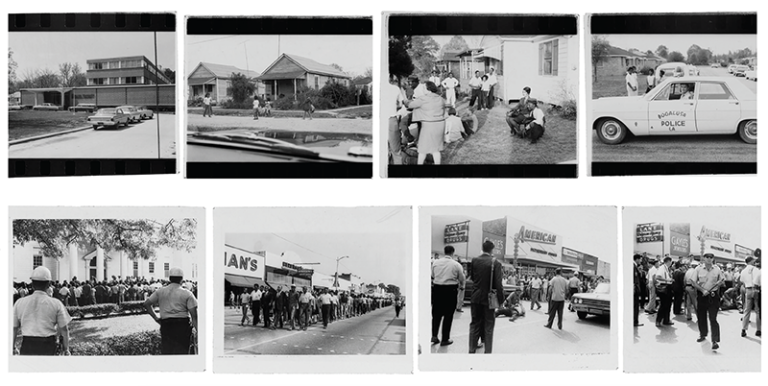
Later that day, my assigned Deacon arrived to take me again to the Charity. On its first floor, the benches in the waiting room were obviously segregated. On the second floor were two large pavilions for women. My Deacon companion identified faded spaces above the entrances, from which racial designations had been removed recently.
One pavilion seemed cavernous; its surfaces were covered with peeling olive paint. It was filled with Black women lying in beds arranged in parallel as if in a sardine can. An aroma of urine permeated the air. A nurse’s assistant sat at a table reading the Bogalusa Daily News, ignoring complaints.
The other ward, however, was less crowded. Its walls had been recently painted and its air conditioning was working well enough. White women in hospital garb lay in beds, their heads on plump pillows. An attendant went from bed to bed filling glasses with cold water.
I climbed the stairs to the second floor, where the two men’s wards were located. The racial distinctions between the two wings on the first floor held for the second. The conditions in those wards, especially those where there were only Black patients, reminded me of what I had witnessed during my medical internship at New York City’s Bellevue Hospital, full of coughs and the smell of suffering.
Blue notes
I had been in Bogalusa for five days, visiting, gathering information and documents, and taking photographs, when I told everyone that I had finished my survey and wanted to leave soon. A few members of the Deacons, including Bob and A.Z., invited me to have a parting beer with them at the Blue Room Tavern in the Black center of town. It was April 4.

I was happy to accept. We had become comfortable with each other—and I had become entirely converted to their cause. I was sipping my second beer when the blue lights of a squad car came through the open door. Two policemen entered the bar; one ordered me to stand up, marched me out the door, and frisked me under the fluorescent glare of the bar’s sign. He pushed me into the back of the squad car with Dolores, who had served me, and we were taken to the station.
At the booking desk, the officer glared at me and said, “Dolores served you in a bar that is only for n–—s. You are arrested as a material witness against her.” It turned out that when Dolores served a white man—me—a beer, she had violated city and state ordinances that prohibited individuals of different races from drinking alcohol together.
“Maybe you want a lawyer,” the detective in the police station said before tossing me a city directory and handing me the telephone. I called lawyers listed in the directory and explained my plight. None would help.
An officer pushed me into a holding cell, which held three bedraggled white men and smelled of urine and alcoholic sweat. At about 2 a.m., a policeman opened the cell and said, “You can leave, someone’s paid your bail.”
As I walked out of the station and into the town square, I noticed two dark sedans with Mississippi license plates, filled with white men puffing glowing cigarettes. I had an idea who those men might be—the Klan—so I stepped back into the station and told the officer that I needed to call a taxi. I called Bob and within ten minutes three cars filled with armed Deacons arrived and picked me up. Our cars rushed through the unlit streets followed by the sedans; shots were fired. The Deacon who was in the back seat with me pushed me to the floor.
Jackie was out of town that evening, so I was driven to the home of another Black family with ties to the Deacons. There I learned why I had been released: after my arrest, one of my drinking partners had called the white owner of the Blue Room Tavern and told him to bail me out. Otherwise, the Deacons would burn down the bar.
What the hell are we doing with a gun?” I asked him. “Well,” he said, “as long as it’s not concealed, it’s legal in Louisiana. There’s the Klan out there.
At the Hickses’ home the following evening, I received a call from a lawyer in New Orleans whose firm often represented civil rights workers. CORE and the MCHR had asked him to represent me. He assured me that he would arrange for me to leave Bogalusa and avoid appearing in court, but that it would take some time.
Solidarity
On the morning of April 8, the day slated for the protest march in which CORE’s Farmer was to participate, everybody assembled at the Ebenezer Baptist Church. We sang religious and civil rights songs and ended by holding hands while singing “We Shall Overcome.” The minister gave an encouraging sermon, then asked me up to the pulpit. I presented an emotional summary of the failing and discriminatory health care in the city, told all that their cause was just, and said I was honored to be with them in their quest for liberty.
On Sunday, April 11, eight days after my arrest, the city attorney telephoned to say that he had dropped charges against me. I was free to leave Bogalusa. I learned later from a court filing that the city attorney was an Exalted Cyclops of the local Klan klavern.
The next morning, Bob drove me back to New Orleans where I interviewed a physician at the state health department to learn more about the department’s activities and about health statistics in Louisiana. I flew to Washington, DC, the following day, and began assembling data and notes for my report to the MCHR.
The MCHR used my report to mount a comprehensive campaign in 1965 to address the consequences of racial discrimination on health care in the state of Louisiana. In August, the executive director of the organization wrote to me saying that my paper, now recognized as the Rapoport Study, was going to be used by all the MCHR volunteers who left for Louisiana in the summer.
After I left Bogalusa, the NAACP sued the Charity in federal court, and won. Indeed, by early 1966, all public hospitals in Louisiana had been desegregated, as had nonpublic health facilities that received federal reimbursement funds under the newly passed Social Security Medicare Act.
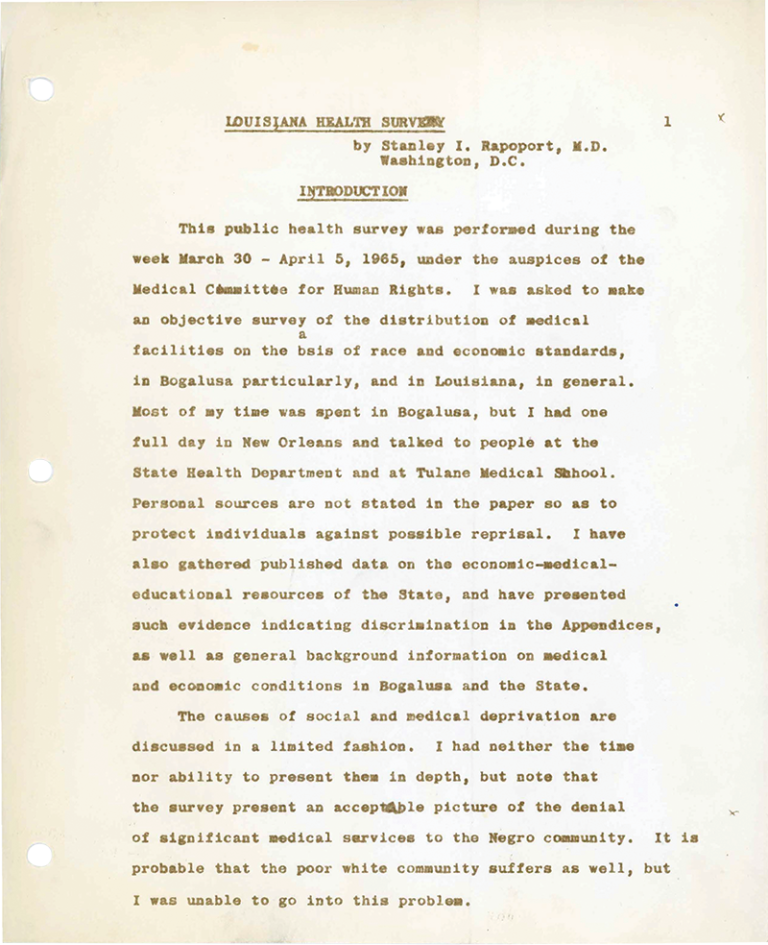
From our lips
In 1967, A.Z. and Bob flew to Washington to testify in a desegregation labor dispute with Crown Zellerbach. Both visited Judy and me at our home.
After they returned to Bogalusa, I never saw them again. Their contributions to civil rights and racial equality were unyielding and glorious. They have passed away, as have so many others whose work was critical to the civil rights movement in Bogalusa and across the South.
Today, in Bogalusa, the Hicks house in which I stayed is listed for significance on the National Register of Historic Places and is slated to become a civil rights museum; historical documents from that time are being assembled in a digital collection for the museum. Photographs that I took while in Bogalusa, my associated documents, and my medical report and related correspondence from CORE and the MCHR will be part of a museum exhibition and are available now on the Louisiana Digital Library website. I am on the board of directors of the planned museum.
One Sunday morning each month, I participate in a prayer circle with Jackie and the extended Hicks family on a common telephone line. We celebrate the progress that was made in removing segregation and attaining equal rights for the Black community in Bogalusa, but also focus on what remains to be done to achieve racial equality and equity in our country.
Stanley Rapoport, MD ’59, is a retired researcher who spent much of his career in the intramural program at the NIH. He resides in Washington, DC, with his wife, Judith, also MD ’59.
Images: Chuck Cook/The Times-Picayune/1988/Capital City Press/Baton Rouge, Louisiana (top); the Robert “Bob” Hicks Foundation/Robert Sobol Collection/photo by Barbara Sobol/Louisiana Digital Library (Hicks in front of CORE office); Photograph by Anne Meuer/Ronnie Moore papers/Amistad Research Center/New Orleans, Louisiana (Rapoport and Hicks at meeting); The Robert “Bob” Hicks Foundation/Dr. Stanley Rapoport Collection/Louisiana Digital Library (all other images)